Anyone who publishes content online needs to know what keyword search volume is and how to use it to their advantage.
Let’s start with the basics.
Keyword Search Volume: What It Is & Why It Matters:
What Is Search Volume?
Keyword search volume is the estimated number of monthly searches for a given search engine query.
For example, Semrush’s Keyword Overview tool shows that “influencer marketing” has a global search volume of 122,700. And around 14,800 of those searches occur in the U.S. each month.
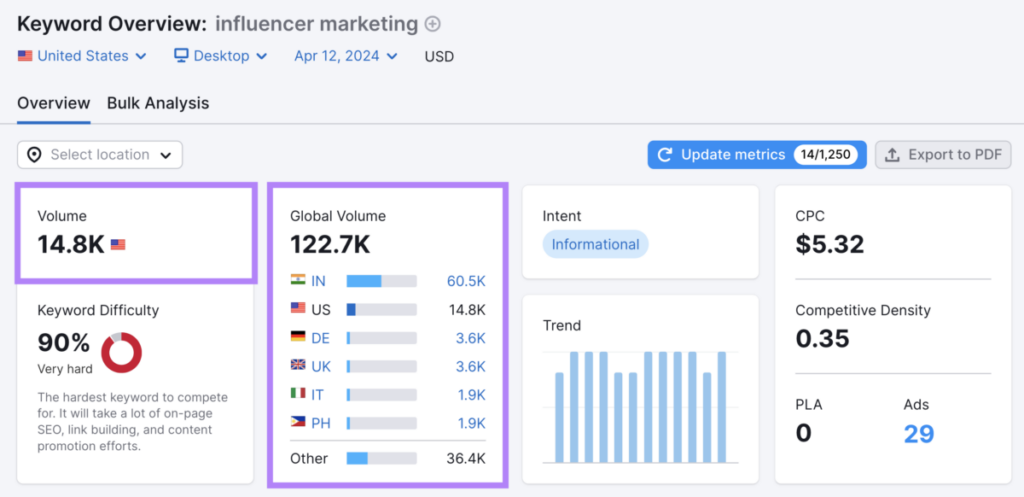
Semrush’s keyword volumes are based on Google searches from the past 12 months. Because the vast majority of searches occur on Google.
And Semrush uses various data sources and complex algorithms to calculate the volumes for billions of keywords. To come up with a search volume metric that’s the most accurate on the market.
You can try out Semrush’s keyword tools now by creating your free account.
Why Are Search Volumes Important?
Keyword search volumes are important in search engine marketing (SEM) because they indicate how many people the search results for those terms could reach each month. Which indicates how beneficial it might be to earn a spot.
So, they help you decide which keywords to target and prioritize through:
That said, there are many other factors to consider alongside search volume.
One example is keyword difficulty. This measures how hard it is to earn a high spot in the organic results—one that users are more likely to see and click.
Keywords with higher search volumes tend to have higher difficulty scores, because they attract more competition from other sites. So, you might be better off targeting lower-volume keywords in some cases.
How to Find Keyword Search Volumes
You can find keyword search volumes with a variety of Semrush tools. And use the insights to inform your content and/or search advertising strategy.
Let’s explore some of the best keyword research methods.
Find New Keywords and Their Volumes at the Same Time
You can find new keywords that you might want to target and their search volumes with Semrush’s Keyword Magic Tool.
After creating your free account, enter a term to base your research around (e.g., “influencer marketing”).
Then, choose your target country and click “Search.”

The tool will provide a list of “Broad Match” keywords that include your starting term or a close variation.
You can see the search volumes for your target country in the “Volume” column. (Keywords are sorted from highest to lowest volume by default.)
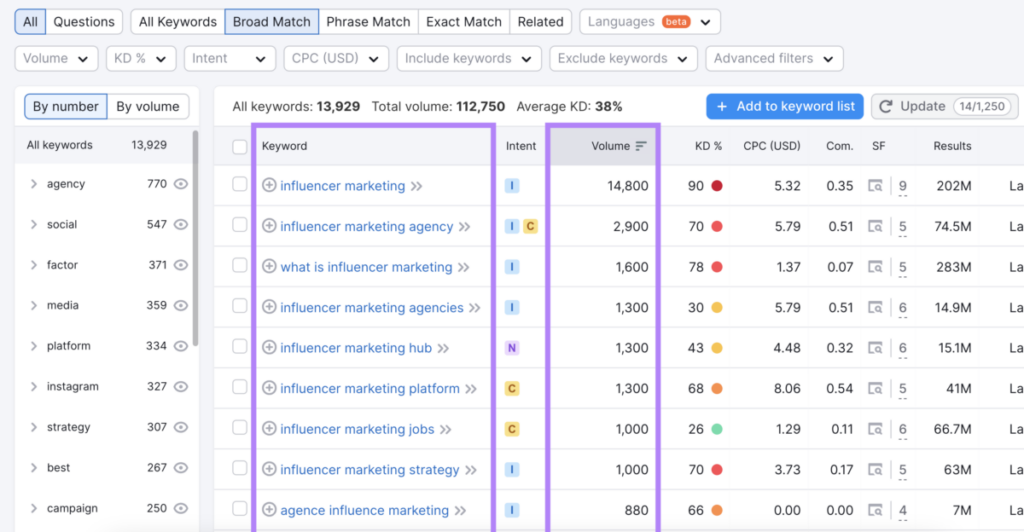
On the left-hand side, you’ll find commonly occurring terms in your results.
Click “By volume” to see which modifiers are searched most—this is a great way to identify popular subtopics in your niche.
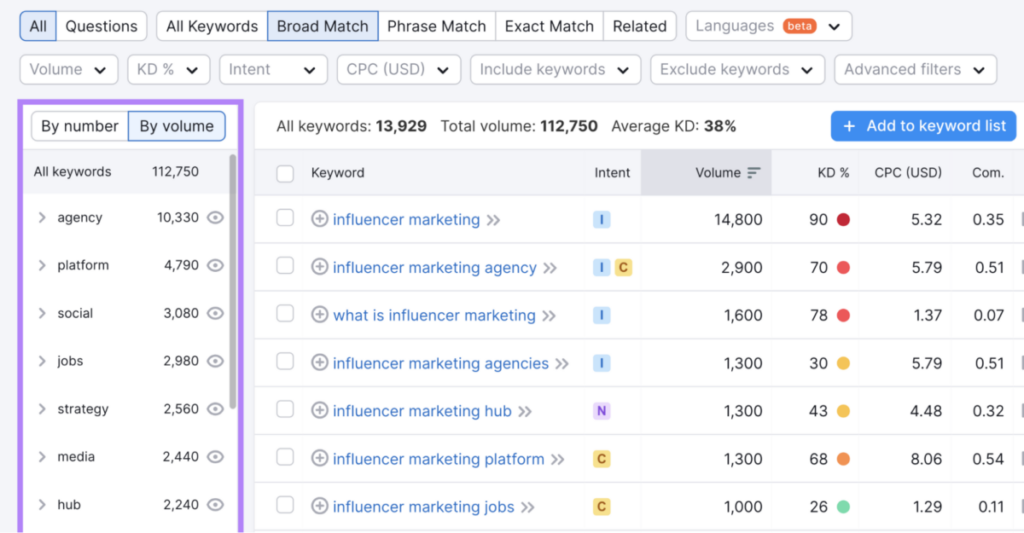
Just remember to consider other factors (like keyword difficulty—“KD %” in the tool) before choosing your target keywords. You can get detailed advice in this keyword analysis guide.
Note: You can find up to 100 keywords a day (10 searches with 10 results each) with your free Semrush account. To increase your limits and unlock other benefits, claim your free Semrush trial.
Analyze Your Competitors’ Keywords
With Semrush’s Keyword Gap tool, you can compare your keyword rankings against competitors’. And gather useful metrics like Google search volumes.
Simply enter your domain and up to four competitors’ domains.
Choose which type of keywords you’d like to focus on:
- Organic keywords: Keywords that trigger a top-100 unpaid result for one of the chosen sites
- Paid keywords: Keywords that trigger a text-based search ad for one of the chosen sites
- PLA keywords: Keywords that trigger a product listing ad (PLA) for one of the chosen sites
Then, select your target country and click “Compare.”
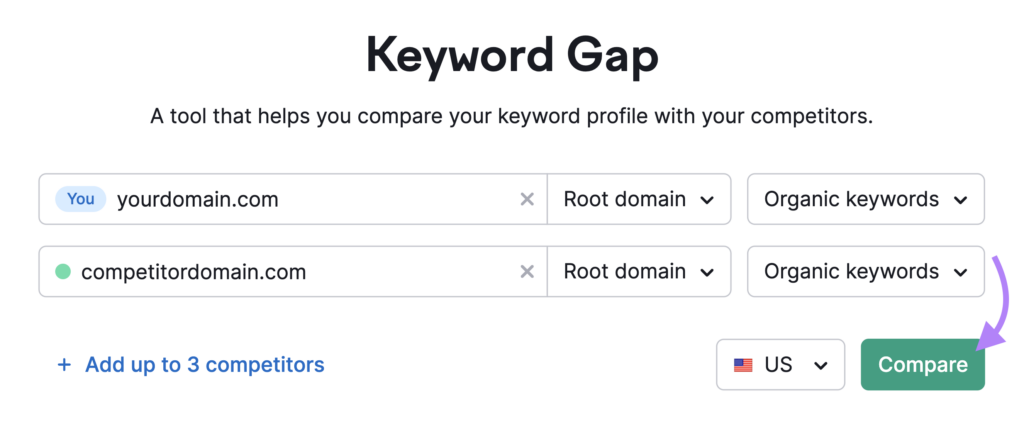
Scroll down to the keyword table to compare the data across sites.
The “Missing” tab shows keywords that all competitors rank for but you don’t. So, they could be worth targeting—especially if they have high search volumes and low difficulty scores.

You can also find new keyword ideas in the “Untapped” tab. This shows search terms that at least one competitor ranks for but you don’t.
Use the “Volume” filter if you want to focus on the most popular search terms.
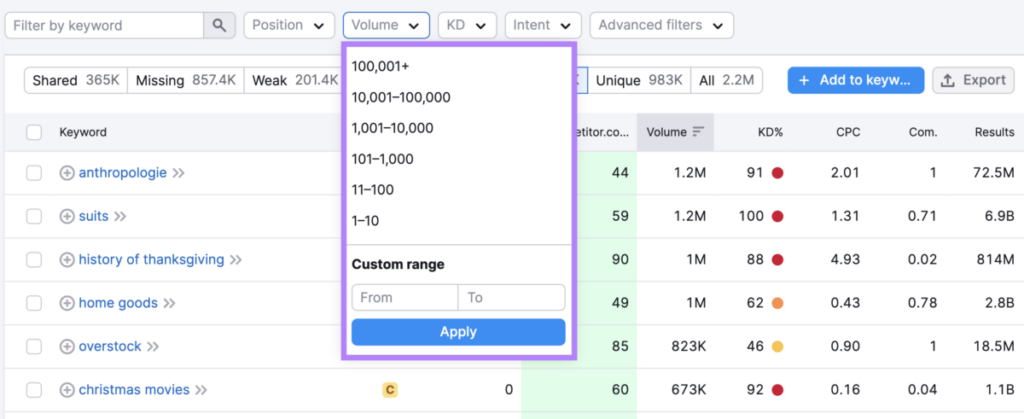
Collect Volumes for Specific Keywords You’re Interested In
You can find search volumes for specific keywords you already identified with Semrush’s Keyword Overview tool.
To check a single keyword, enter the term and choose your location. Then, click “Search.”
(If you have a Semrush trial or subscription, you can select a more specific location like a city or state. To understand what highly localized audiences search for.)
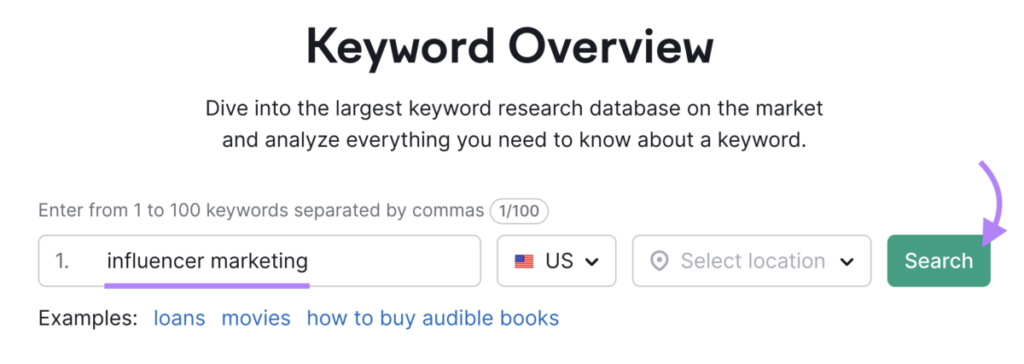
The “Volume” section shows the average monthly search volume for the country you selected.

To check multiple keywords in Keyword Overview, enter your terms separated by line spaces or commas.
(If you have a Semrush trial or subscription, you can search up to 100 keywords at once.)
Then, choose your target country and click “Search.”
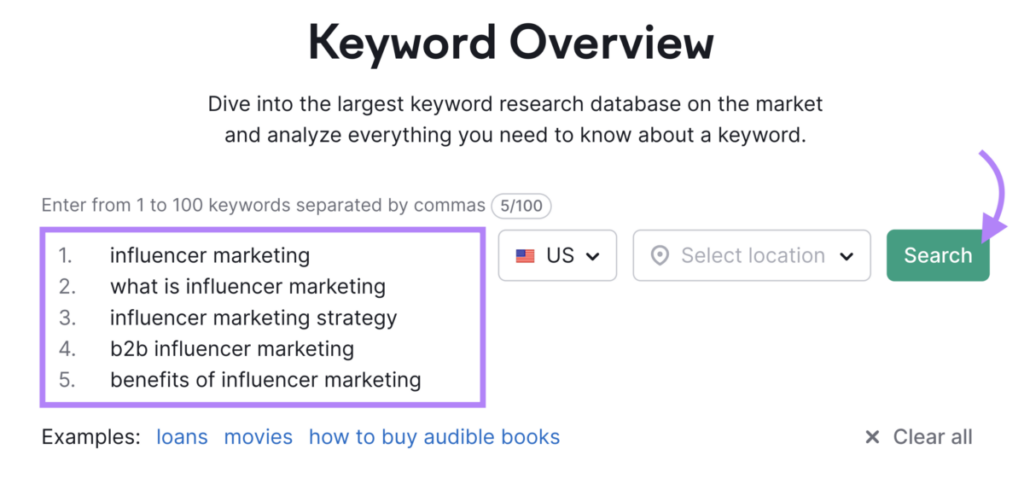
You’ll find the search volumes in the “Volume” column.
As with Semrush’s other keyword search volume tools, you’ll also find useful metrics like keyword difficulty.

Check Your Current Keywords
To quickly see what keywords you’re already ranking for and gather their search volumes, enter your domain into Semrush’s Organic Research tool.
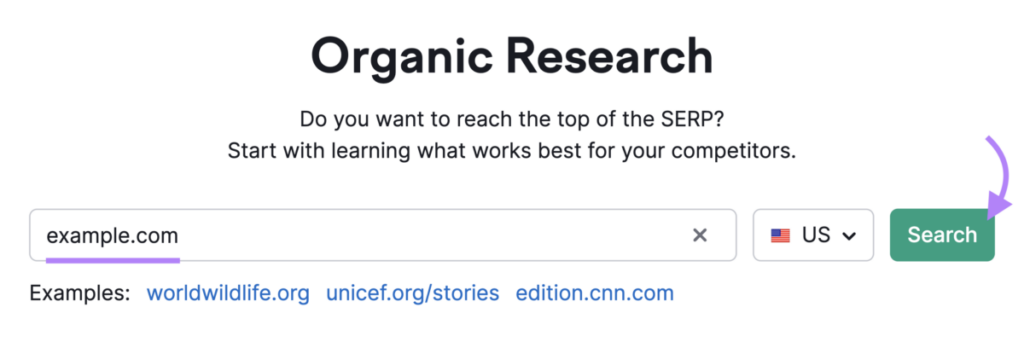
Then, go to the “Positions” report.
You’ll see keywords you rank for, the positions you rank in, and the keyword volumes. Alongside other useful data.

If you see an icon in the “Position” column, that means you rank for a SERP feature.
This is a non-standard element on the search engine results page (SERP). Such as a People Also Ask box or an image carousel.
These features can help you get more attention and clicks.
Keyword Search Volumes vs. Cluster Search Volumes
Keyword clustering is the process of grouping search terms that should be targeted on the same page or with the same search ad. Because users searching for those similar keywords share a common goal.
For example, an influencer marketing overview could rank for all these keywords (and many more):
- “what is influencer marketing” (1,600 searches/month)
- “influencer marketing definition” (390 searches/month)
- “influencer marketing meaning” (70 searches/month)
This means the total volume for this topic is over 2,000 searches per month.
As you can see, keyword clustering gives you a better understanding of potential reach. And helps you optimize your content better—because you’re not focusing too much on one search term.
You can easily create and analyze keyword clusters with Semrush’s Keyword Manager tool.
Enter a term to base your search around, choose your country, and click “Create list.”
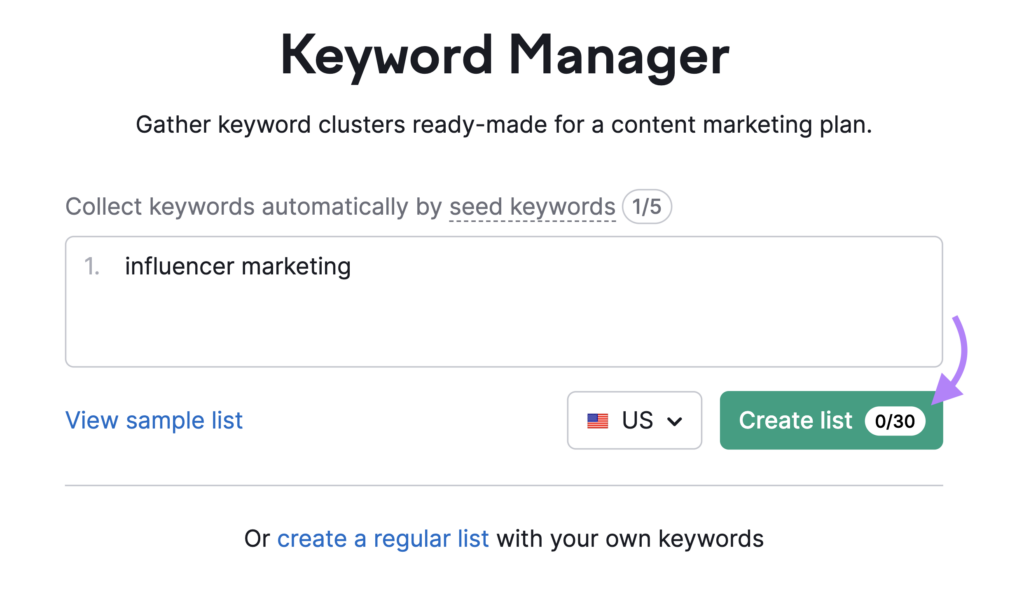
The tool will present a list of keyword clusters.
On the right, you can see the total search volume for each one.
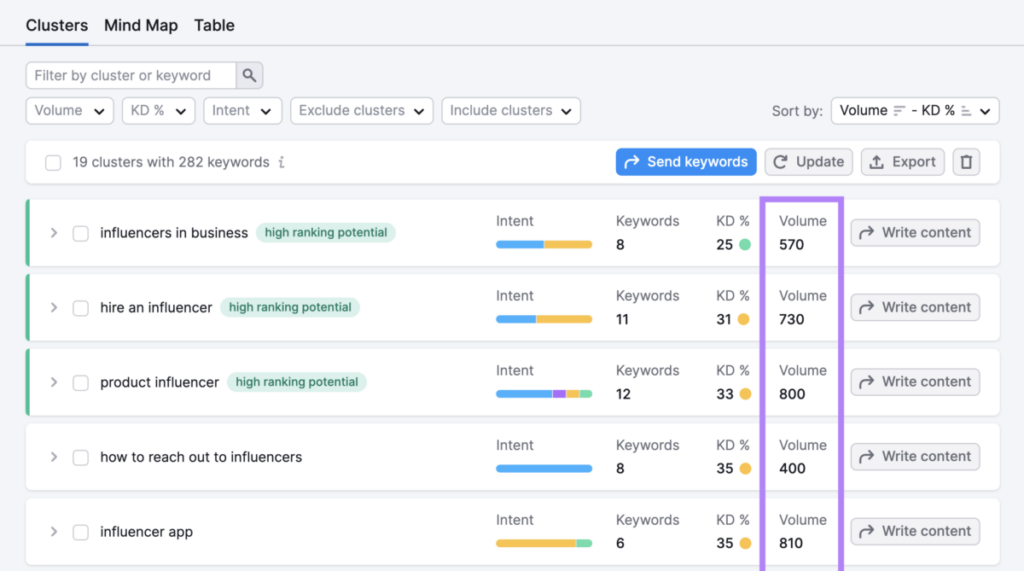
Click the arrow to see all the keywords in each cluster. And their individual search volumes.
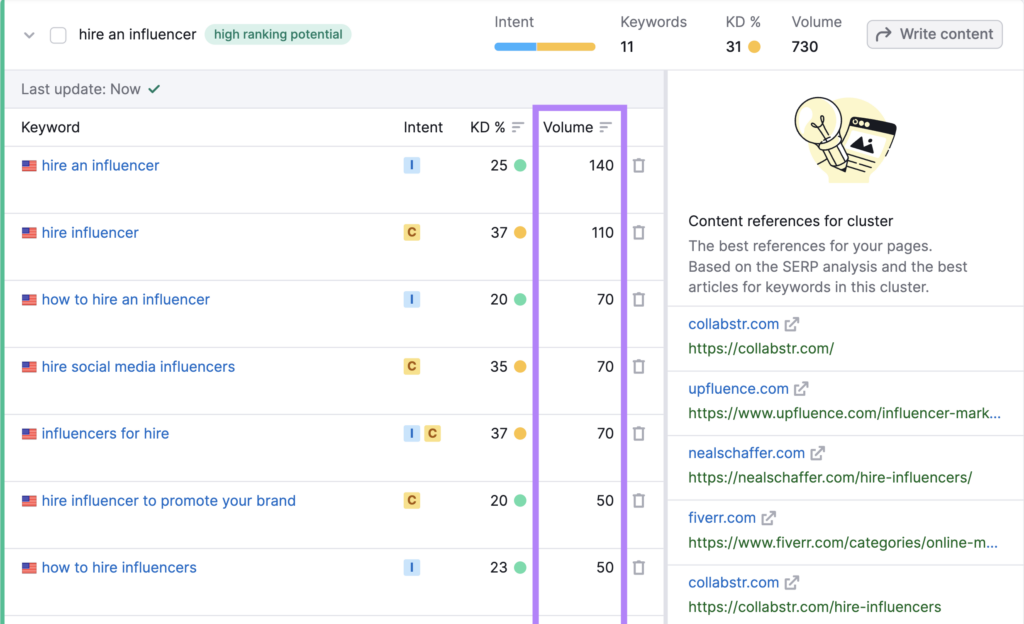
When targeting a keyword cluster, we recommend that you pick a primary keyword—the main keyword to base your content or campaign around. By considering factors like its volume and difficulty.
Other keywords in the cluster will become secondary keywords by default.
Understanding Trends That Impact Search Volume
Looking at search volume trends helps you predict your potential reach in the future.
In Semrush tools like Keyword Overview, the “Trend” graph shows how the estimated number of searches has fluctuated over the past 12 months.
And there are six main trends to look out for:
Consistent Interest
Keywords that attract a similar level of interest throughout the year (and are likely to continue doing so) are called evergreen keywords.
For example, “influencer marketing strategy” has a relatively stable trend graph:
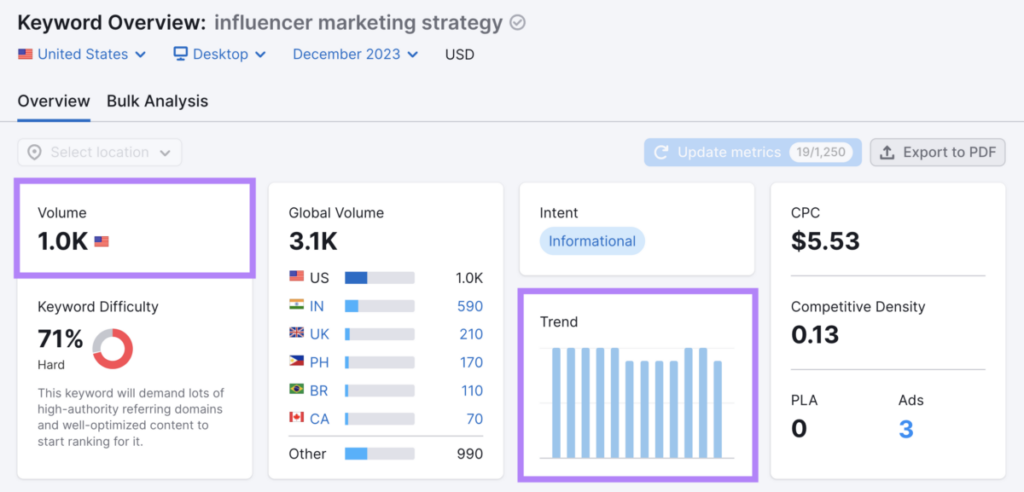
Its average monthly search volume is 1,000. So, we can expect this keyword to get around 1,000 searches in any given month. Assuming no major changes in the niche.
If you create evergreen content and maintain a stable position in the search results, evergreen keywords have the potential to consistently drive long-term traffic.
Seasonal Peaks
Seasonal keywords are predictably more popular at certain times of year. Usually because of an annual event.
For example, “valentines flowers” has an average monthly search volume of 5,400. This means that the total number of yearly searches is around 64,800 (5,400 x 12).
And almost all of those searches occur in January and February:
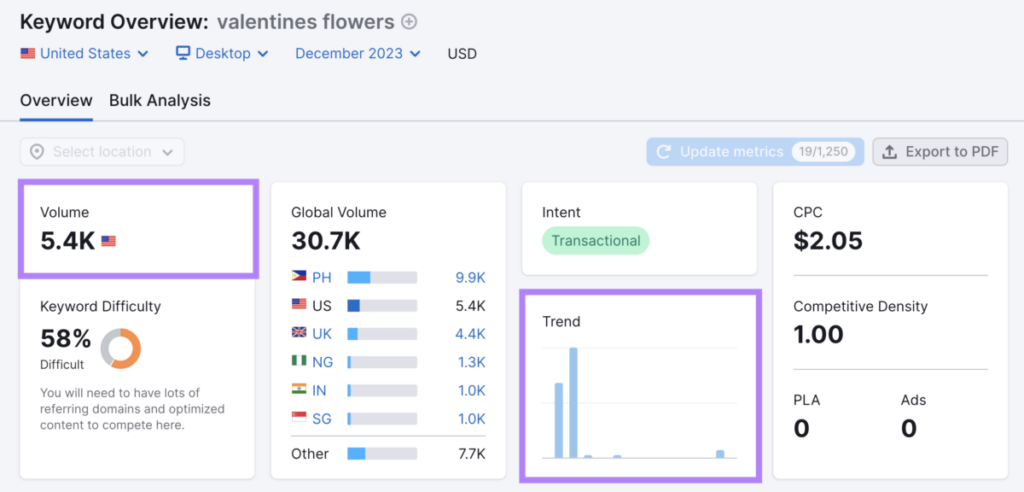
If you try to target this keyword after Valentine’s Day, you’re unlikely to see results until the following year.
To check whether a trend repeats yearly, perform a longer-term analysis through Google Trends.
Head to the Google Trends site, enter your keyword into the search bar, and click “Explore.”
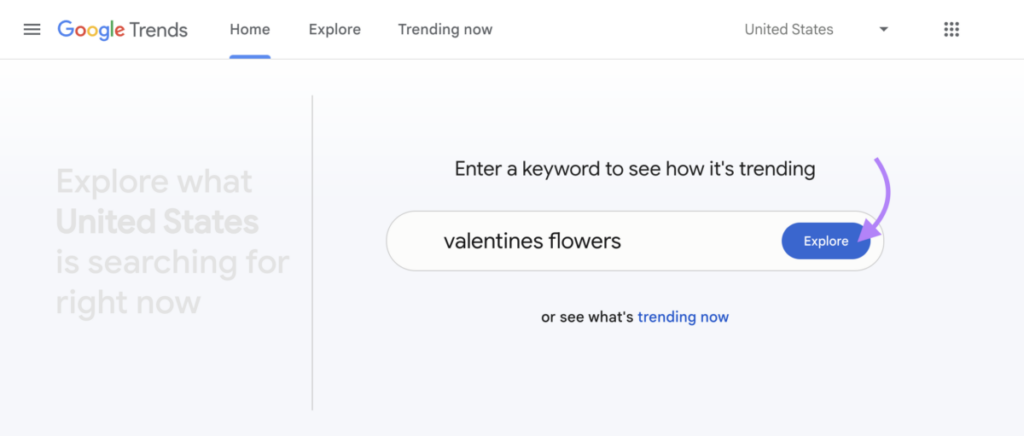
Then, change the time range to the “Past 5 years.” (You might want to change the location, too.)
You can now see whether there’s a yearly pattern in the level of search interest.
Like there is here:
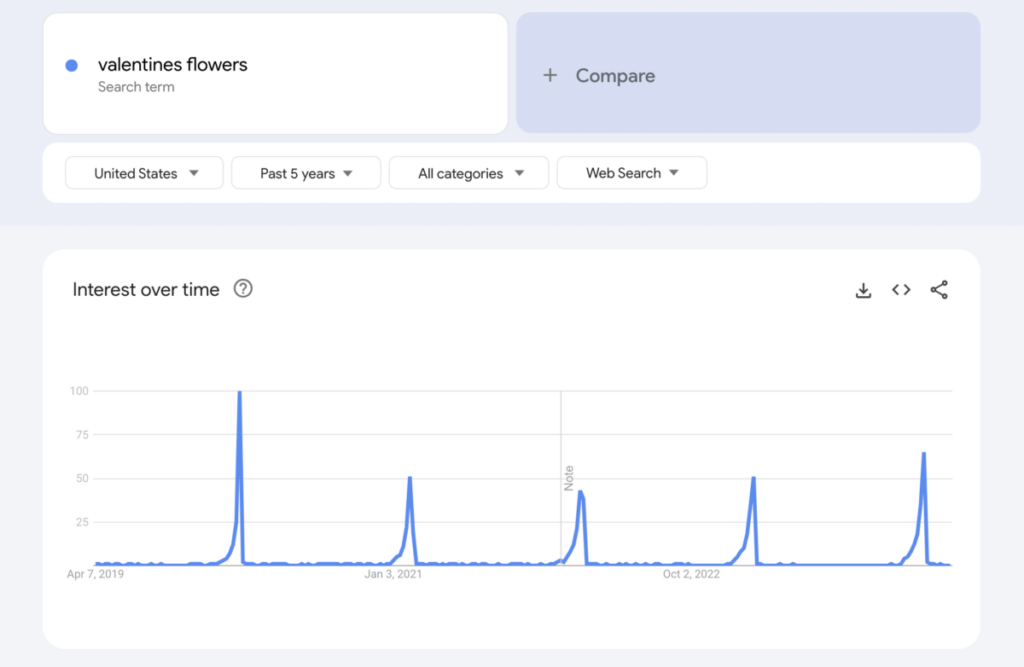
Cyclical Trends
The popularity of some keywords is tied to non-annual events.
For example, “the olympics” searches spike around the summer and winter events. Which alternate every two years.

To understand these cyclical search trends, you need to consider the wider factors affecting your market. Like economic conditions, cultural shifts, and technological advancements.
Remember that average monthly search volumes will be different depending on which stage of the cycle you’re in.
If you’re targeting these terms (or seasonal terms) through SEO, you should try to publish your content a few months in advance of interest increasing. To give yourself time to establish rankings.
If you’re targeting these terms through search advertising, try to plan your campaign around times of interest. Particularly when interest is peaking.
Sudden Increases
If you see a sudden spike in searches, it suggests that the topic is trending on social media. Or being covered in the news.
Some trends emerge rapidly and remain popular.
For example, “lip oil” exploded on TikTok in December 2021. And has since maintained a high level of interest.

On the other hand, some trends are fads that quickly fade out.
For example, “blueberry milk nails” went viral on TikTok last year. But interest soon dropped—and is unlikely to return anytime soon.
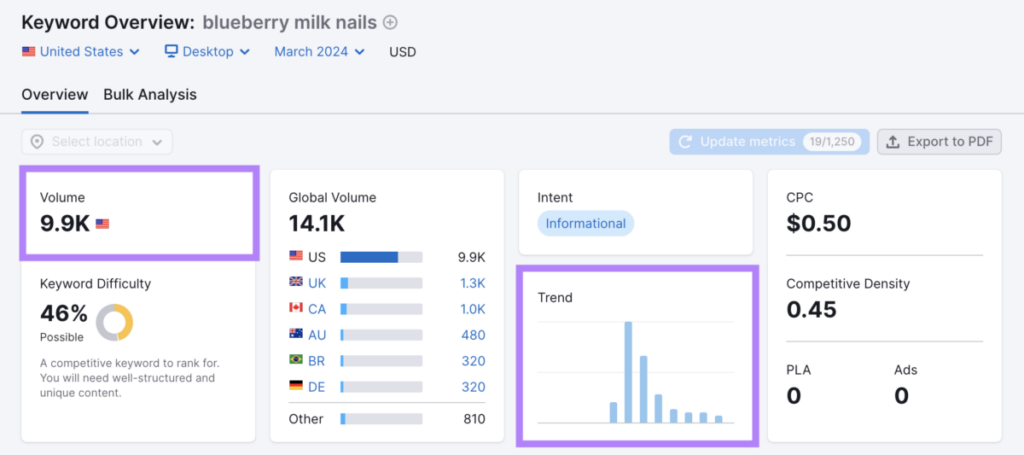
If you identify trending keywords early on and act quickly, there’s potential to get results.
But it can take weeks or months to gain organic rankings for new keywords. And in that time, the trend may have died out.
So, you might want to focus on search advertising instead. Or wait and see how the trend plays out.
One of the best ways to spot trending keywords is with Semrush’s Topic Research tool.
Enter a topic, choose your country, and click “Get content ideas.”
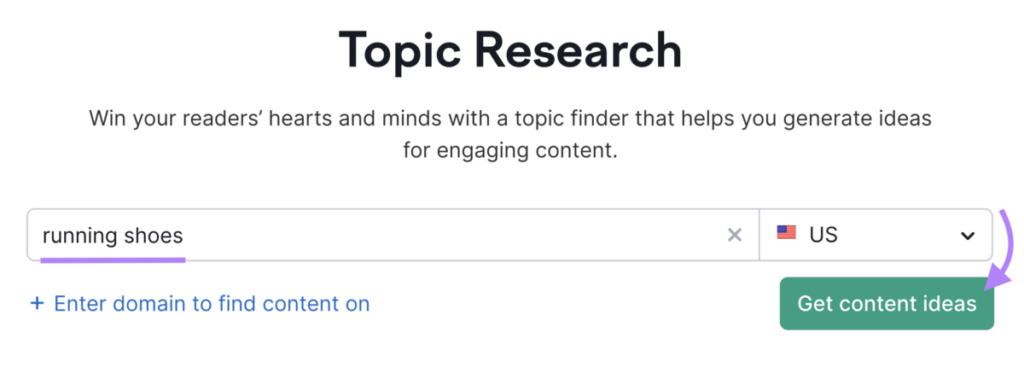
Then, switch the toggle next to “Trending subtopics first.”
And explore subtopics with the flame icon.
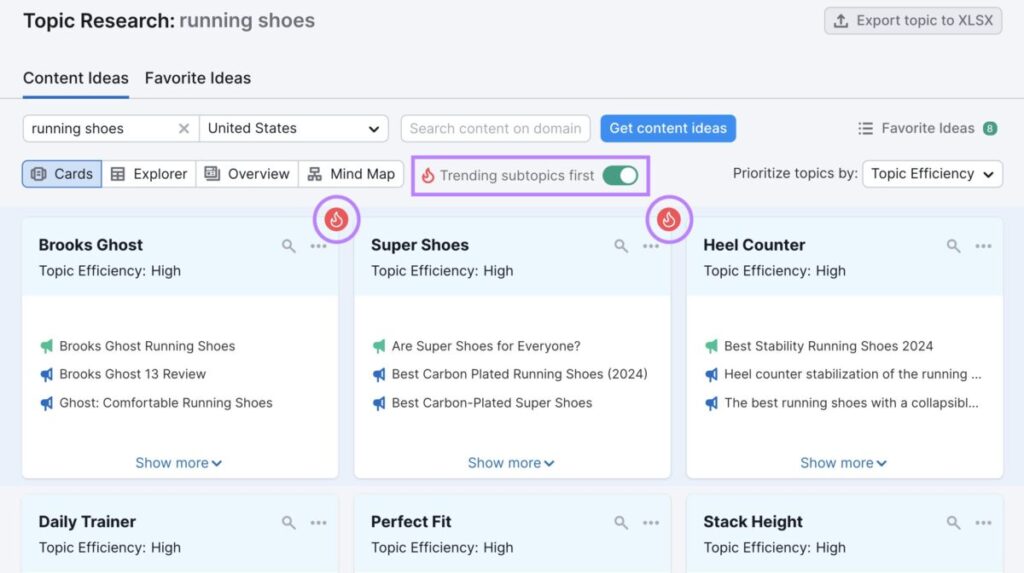
For more ways to discover trending topics, take a look at:
Gradual Increases
A gradual, long-term incline suggests that interest in a search term is naturally growing.
For example, Perplexity AI is an AI-powered search engine that came out in August 2022. And its name has attracted increasing interest over recent months
You can clearly see this in Semrush’s Keyword Overview tool:
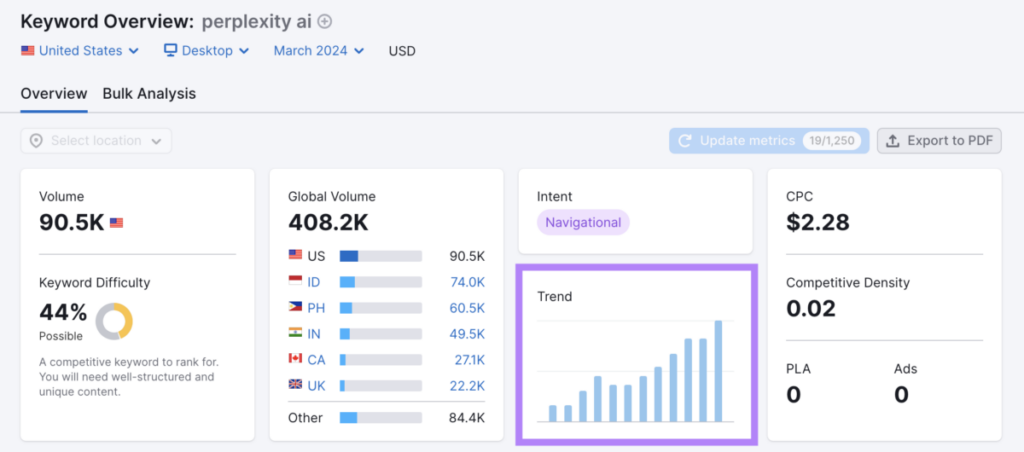
In cases like these, the search volume tends to underestimate current and future search demand. Because it considers months when interest was lower.
So, don’t be too concerned if the number seems small. These keywords can provide great opportunities to get ahead of your competitors.
Gradual Decreases
If a keyword is gradually declining in popularity (and not because of a temporary event), this indicates naturally diminishing interest in the topic.
For example, “what is the metaverse” has been on a downward trajectory for several months.

This suggests that the Metaverse is becoming more widely known, so people are less interested in a basic introduction. And it may also indicate that overall interest in the topic is diminishing.
Either way, creators should be cautious before investing resources into keywords like these. Because actual search volumes are likely to be lower than current volume figures suggest—and could drop further.
How to Track Your Keyword Performance
Monitor your rankings in Google’s organic and paid results (and in any location) with Semrush’s Position Tracking tool.
That way, you can see if your search marketing efforts are paying off. And take corrective action if not.
After setting up the tool and importing your keywords, you’ll see the “Landscape” report. Which highlights some of the most important findings and metrics.
Click the cog icon to switch between “Organic” and “Google Ads” results.
![]()
Next, head to the “Overview” report.
You’ll immediately see a “Visibility” graph that gives an indication of your overall performance. (A score of 100% means you rank No. 1 for all tracked keywords.)
![]()
Scroll down to see a full keyword breakdown.
You can see your ranking positions for those terms. Plus the corresponding search volumes, difficulty scores, and more.
The “Est. traffic” column provides a traffic estimate based on average Google click-through rates.
![]()
You can learn about your actual organic traffic in Google Analytics and Google Search Console. And see how many clicks your sponsored results get via Google Ads.
Visit the linked guides to learn more about these tools.
Start Finding Popular Keywords
While there are many other factors to consider, it’s important to target keywords that your audience actually searches for.
Otherwise, you’ll waste resources and see poor results.
Semrush’s keyword database has over 25 billion keywords to discover.
Create your free account to see what your audience searches for.








